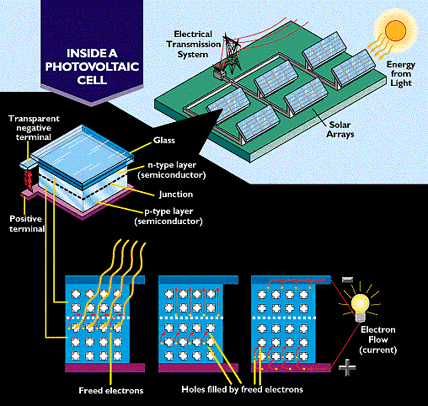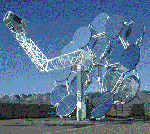|
Electrical Generation
The generation of electricity from solar energy can be achieved through two major technology alternatives. One uses the light from the sun to generate electricity directly, (photovoltaic technologies), and the other uses the heat from the sun to increase the temperature of a working fluid which-in turn can be used to generate electricity, (solar thermal technologies). Each of these major alternatives can, in turn, be subdivided into variants of the major technology. Photovoltaic technologies fall into crystalline, multi-crystalline, thin-film or concentrator variants while the solar thermal technologies fall into trough, power tower, dish engine and thermal electric variants.
Photovoltaics
Generally speaking, How a PV Cell Works describes the use of a semiconductor material that is exposed to sunlight. The energy of the incident light displaces electrons from their normal atomic orbits and an electrode grid structure on the surface of the semiconductor collects these electrons and makes them available for use in an external circuit. This is very similar to the way that the chemical reaction and the electrodes in a dry battery cell make electrons available for external use.
The terms crystalline, thin film and concentrator describe the manner in which the semi-conducting material is processed and optimized as a photovoltaic cell. Crystalline cells are fabricated from ingots of the semiconductor material, usually silicon, that are cut into relatively thin slices, processed to optimize the electron collection efficiency and laminated into a protective enclosure. Thin film cells are extremely thin layers of semi-conducting material that are evaporated onto a substrate, and concentrating cells use a plastic lens to concentrate sunlight from a large area onto a much smaller area of crystalline semi-conducting material. All types have their merits and problems and are described in detail in the referenced locations.
Download the Arizona Consumer's Guide - this booklet is designed to guide you through the process of buying a solar electric system. This document is somewhat out of date (2000) and does not mention some newer information. NOTE: You will need Adobe's Acrobat Reader to open, view, and print this document. Acrobat is freely available and can be downloaded from Adobe's Web site. Arizona Consumer's Guide (PDF Format)
Visit the National Geographic's web site and take the: PV Quiz
Solar Thermal
Both the trough and power tower solar thermal technologies use mirrors to concentrate the heat from the sun onto a vessel containing a heat transfer fluid. The fluid is then pumped into a steam generator where the heat is transferred to water turn it into steam. The steam can then be used to spin a conventional steam turbine connected to a generator to make electricity. As you can see, the size of the concentrating systems makes them impractical for homes.
In the case of the trough, the mirror is a long parabola with a steel tube containing the heat transfer fluid running along the focal axis of the mirror. The axis of the mirror is usually aligned in a North-South direction and the mirror is rotated from East to West as the day progresses so that the energy from the sun is continually focused onto the steel tube. Rows of mirror/tube assemblies are used to form large multi-acre solar fields from which the heated transfer fluid is collected and used in the generation of steam.
The power tower system is a little different in that all of the transfer fluid heating is achieved in a heat receiver on the top of a tower located in the center of a field of computer controlled mirrors, or heliostats. Cold fluid is pumped up to the top of the tower, the heliostats focus the sun's energy onto the receiver and heat the fluid which is subsequently returned to the ground and used in a steam generator in the same way as the heat transfer fluid in the trough system.
Dish/engine systems are somewhat different in that the heat from the sun is used to heat a working fluid within a heat engine. The rotating shaft of the engine is connected to a generator, which produces electricity without the need to go through a steam generation process. The engine is located at the focal point of a parabolic dish mirror, which is made to track the sun across the sky throughout the day.
Good Resources:
|









 OR
OR 
